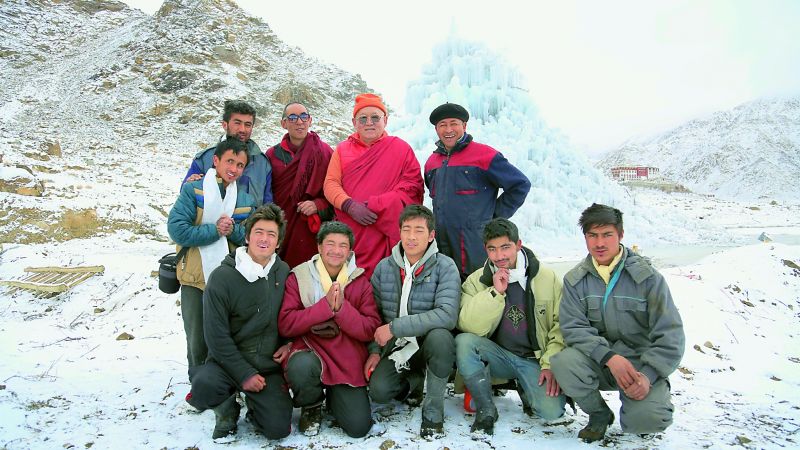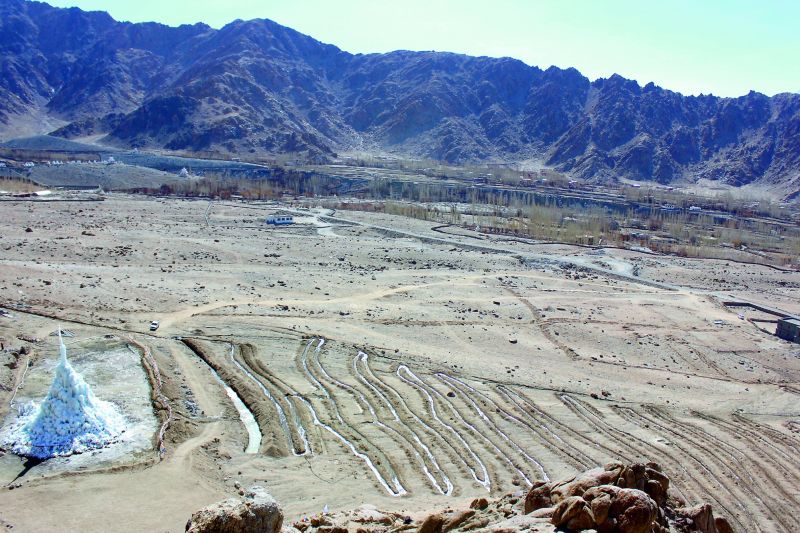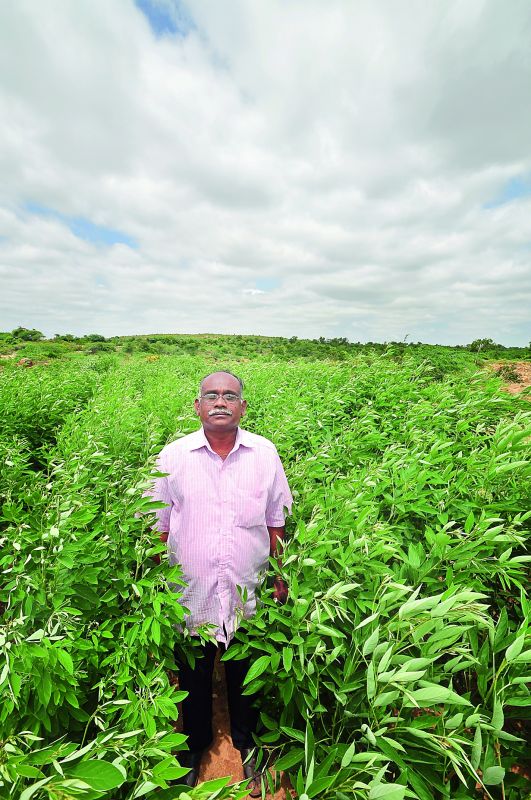For Water
Ideas, and people, who are trying to save the one element that makes our planet unique.

The relentless Hyderabad sun, and the city’s sheer number of humans, seem to be slowing down Sonam Wangchuk. Everywhere he looks, there’s either a reporter trying to fire off a question or an autograph hunter pushing his way through. Often, they are the same person. The crowd around Wangchuk stands mesmerised. Mostly comprising teachers and staff of a rather large city school — that has invited him over for a speech — the cordon of humanity around him are keen on discussing radical ideas, innovation… the next big thing. ‘Should I ask him if he is an idiot?’, a reporter is heard running his question with a colleague.
The other man turns around with the sort of face one makes after a whiff of armpit. The query is immediately struck off. Sonam Wangchuk is not an idiot. In fact, he is one of the smartest people alive at the moment. And that ‘idiot’ reference is thanks to Aamir Khan, who based one of his characters from a movie on this unassuming engineer from Ladakh. “It’s really not based on my life… it’s just a movie,” says Wangchuk, to almost every query about his link with Bollywood. But it’s not just the movie that has made the Ladakhi engineer famous. Wangchuk is the 2016 winner of the Rolex award for enterprise — in the environment category. He was selected for creating something so incredibly unique and useful that it fights forces of nature to bring sustenance to thousands of acres of arid landscape.
 No great lakes: California’s Folsom Lake, pictured here in 2011 (left) and in 2014 (right)
No great lakes: California’s Folsom Lake, pictured here in 2011 (left) and in 2014 (right)
The Ice Stupas
Towering over Ladakh’s landscape, ice stupas can reach a height of over 50 feet. “They are artificial glaciers. But instead of ice forming horizontally, we have managed to create a vertical model that can hold the ice until the summer months. And during the dry seasons, this water can be used to feed the fields,” says Suryanarayanan Balasubramanian, a young volunteer from Chennai, who is currently at work on the project. Ladakh has for hundreds of years relied on glacial melt for its water but global warming has had these massive ice sheets on the retreat — not good news at all for a region that gets just about 80mm of rain annually. At risk are wildlife, humans and flora. The stupas are designed in such a way that they don’t melt until the summer. Imagine them as a frozen reservoir that is timed to release water just when you need it the most. Pipes carry the water from the stupas to the fields and the creation of careful channel means not a drop is wasted. There are no moving parts, no computer assistance and the things don’t even require human intervention.
The ice stupas then, mark the pinnacle of what humans can achieve using traditional ingenuity and a few spades. One of the very first ice stupas, on the outskirts of Phayang Monastery, now feeds nearly 5,000 poplar trees. “But we need to create incentives for people to start these,” says Wangchuk. “If we make everyone a stakeholder in the ice stupa project and have commercial benefits to the plan… it could work on a whole new level. We could even have water entrepreneurs. Why waste an idea? These ice stupas can get wider in scope and application.” They already have. Switzerland has reached out to Wangchuk and the plan is to tap into the ice stupas’ tourism potential. A skiing town near glitzy St Moritz want the stupas installed as part of the winter tourism attractions and to offset damage from their own retreating glaciers. In exchange, the precision-loving Swiss will help the resourceful Ladakhis enhance the water supply systems in their villages.
 All together: Sonam Wangchuk, standing fifth from the left, with one of the teams that worked on the first ice stupas in Ladakh
All together: Sonam Wangchuk, standing fifth from the left, with one of the teams that worked on the first ice stupas in Ladakh
Not a drop to drink
India is heading towards a full-blown water crisis. As we write this, multiple metro cities are experiencing severe drops in groundwater levels and with reduced rainfall, cities that were water-wise healthy a few years ago, are now fighting for a sip. Last year, a study by the Indian Institute of Science hit the alarm switch for Bengaluru. Research revealed the city had lost 79 per cent of its water bodies. There had been 925 per cent increase in concretisation and close to 75 per cent of the Garden City’s land was now paved. “At this rate, it’ll be all over for us in the next five years,” says a businessman based out of Jayanagar — one of Bengaluru’s most crowded residential localities.
“Every day, there’s a borewell being dug here and they are going deeper to find water. A decade ago, water was not a problem in this neighbourhood but that changed overnight.” Just over 600 kilometres away, in lush green Kerala, an entire lake is fast disappearing. The Sasthamkotta Lake is the largest freshwater lake in the state and it serves nearly half a million people in the district of Kollam. It’s now down to its last drops. The water level here has been depleting at an alarming rate of 50 cms every year and the lake — measuring around 3.73 sq kms — is vanishing from the map. This rapid depletion, according to the experts, is due to greed — an over-exploitation of the resource by those pumping out water for drinking. However, of a total demand of 60 million litres per day (MLD) (the district of Kollam’s requirement), authorities are now able to source a few glasses above 10 MLD from the lake.
 Getting water there: Careful water channels are created to ferry the water from the stupas to the nearby villages
Getting water there: Careful water channels are created to ferry the water from the stupas to the nearby villages
“The land surrounding the lake too has lost its capacity to retain water thanks to extensive sand mining. Water temperature too has shot up affecting aqua life and there’s the flowing back of waste-water from treatment plants nearby. The industrial release has increased the micro-climate temperature associated with the lake. In short, what we now have here is chlorinated, recycled water,” V.K. Madhusoodanan, an environmentalist, tells us. The violent death of such a large water body also sends biodiversity in and around it, into freefall. Which is why Sasthamkotta Lake today has just 20 species of freshwater fish. A few decades ago, there were over 75 thriving species. The lake’s concerned human neighbours have tried everything — from forming human chains to road blocks. But it has been two decades of false promises. “The protests started in 1997. Several announcements were made but no conservation measures were taken up,” says S. Babuji, who has been one of individuals leading the protests.
“Nearly 5,000 local residents were part of that human chain. But to save Sasthamkotta Lake, pumping has to be brought down at least by 40 per cent and it has to be left undisturbed for at least 10 years,” Babuji says. However, a run-through of the population statistics in the region reveal that ‘leaving the lake alone’ is perhaps no longer an option. From Kerala, we travel to one of the most drought-prone regions of the country. To the massive state of Maharashtra — home to some excellent cinema and downright bizarre political drama. Several parts of the state, particularly the Vidarbha and Marathwada regions, have been at the receiving end of an incessant drought. It has caused a considerable dip in agricultural output and caught in this ecological nightmare are thousands of farmers who are reeling under mountains of debt. Over 6,000 of them have committed suicide in the months of 2015 and the following year, and the survivors are desperately digging borewells in the hopes of finding some water for their crops. In Latur, for example, borewells have reached depths of 1,000 feet despite norms limiting exploration to 200 feet.
 A vanishing lake: Sasthamkotta, Kerala's largest freshwater lake, has been disappearing fast, thanks to uncontrolled pumping.
A vanishing lake: Sasthamkotta, Kerala's largest freshwater lake, has been disappearing fast, thanks to uncontrolled pumping.
But there are people struggling to keep both man and planet alive. One such group is the NAAM foundation, that was started by Nana Patekar and Makarand Anaspure. The organisation is scrambling to provide real-world solutions to the region and are widening rivers, adopting villages, introducing group farming techniques and replenishing entire rivers. Tracts of land are being carved out to create river paths and what were once cracked beds, are receiving their first taste of water in years. Another one of NAAM’s aims is immediate monetary assistance. “We have helped families of farmers who commit suicide with immediate assistance of '15,000. We are also helping families to become self-sufficient,” says Shyam Pethkar, a member of the foundation.
 Miracle maker: Engineer Ayyappa Masagi turned around close to 800 acres of bone-dry land in Andhra Pradesh into what you see in this photo
Miracle maker: Engineer Ayyappa Masagi turned around close to 800 acres of bone-dry land in Andhra Pradesh into what you see in this photo
‘Water entrepreneurs’
Worldwide, early signs of an addiction gone wrong are showing. Our sustained need for freshwater has had such a severe impact on the world’s water bodies that many experts claim the next series of wars will be fought over water. In Brazil’s Sao Paulo, drought conditions got so bad that residents in the city of 20 million people started digging through basements and car parks, creating personal wells. In the state of California in the United States as of March 2 this year, the National Drought Mitigation Center said approximately 10.5 million people were in the grip of a drought. On that date, only 25 per cent of the state was experiencing a drought. The state has clamped down on water use and in California’s swanky neighborhoods, enthusiastic washing of cars is frowned upon. Amongst residents, it’s a desperate rush to ration what’s left in the taps. In West Asia, the Emirates are abandoning the race to build skyscrapers to invest more desalination plants. “For us, water is now more important than oil,” Crown prince General Sheikh Mohammed bin Zayed al-Nahyan was famously quoted as saying.
It’s during times such as these that the most frugal minds go to work. Ayyappa Masagi, from Karnataka’s stone-dry Gadag, has managed to pull off the impossible. In under a decade, Ayyappa has implemented turnkey rainwater conservation projects at more than 4,200 locations. These sites include over 70 industrial units, over 200 luxury villas, more than 50 educational institutions and over 3,000 individual homes. He knows water very well. He was just four when he joined his mother to go look for it. “The farmer gets lazy during the rains, cosy during the winters and wakes up only during summer — when he faces water shortage. Why don’t we handle agriculture like an industry? We strategise, plan ahead and invest properly. Even bathing water is not bad water. It can actually be reused,” he says. Ayyappa is mechanical engineer and after 26 years an employed man, he turned to fix a “childhood worry”.
In 2014, he bought around 200 acres of barren land in the district of Anantapur in Andhra Pradesh. The region also borders Karnataka. Now, 84 acres from that piece of land is teeming with life and at least 30 varieties of crop — including ragi and millet, tomatoes, onions, green chillies, etc. The massive farm does not even rely on an external water source because it has its own four artificially-created ponds that were formed using bunds. “So we have three borewells pumping water throughout the day. Farmers working here are paid Rs 16,000 a month and then live on the premises, living off what they grow on the land,” Ayyappa says.
Imagine the possibilities. If one 56-year-old pensioner was able to do this with 86 acres of land, what could a thousand do? Hell, we could have havens such as these every few kilometres! Ayyappa is now helping others scale up. He goes to work after drawing out exact measurements — including the size of the land and available resources. His advice has helped thousands of conservation projects across 11 states. He has also created over 600 lakes. It’s not overnight that he earned the name,
‘Water Gandhi’
“Our country doesn’t need grand plans such as river-linking to tackle water shortage. The solution lies within every single farmer and organisation. We should simply plan ahead… only then will the country be water efficient,” he says.
Which is what Sonam Wangchuk has been trying to explain to the crowd around him. “The minute we make people part of the solution, they will start benefitting from it. Ideas such as the ice stupa can only succeed if they are also potent sources of income. Instead of all this fighting I’m hearing about, we should just all sit down and throw around a few ideas. One of them could save the planet.”
— Additional reporting by Sham Mohamed in Kerala, Prasad Patil in Mumbai and Hoskote Nagabhushanam in Anantapur
